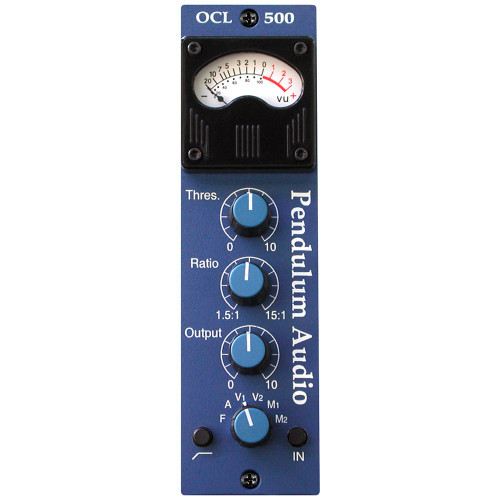The Pendulum Audio DS-500 500-Series De-Esser is a premium-quality Opto De-esser for the 500-Series Format.
Back in 2001, while designing the Quartet Tube Recording Channel, Greg Gualtieri decided that it needed a de-esser as one of the four elements. Though he'd never bothered to look into how they operate - much less built one himself - he blindly went off and started tinkering. Attempts at de-essing via the sidechain of a compressor to pull down the amplitude of the "s" worked ok, but did not sound natural or leave enough of the "s" to make it recognizable.
So, the fast opto cell from the OCL-2 was employed as part of a triggerable LC notch filter, which covers a specific range of fundamental frequency where the "s" is most annoying. By varying the depth and the band-width of the notch, Greg Gualtieri discovered that there is a sweet spot where the "s" is recognizable, but not splashy. Because the sweet spot is often singer-dependent, he added a depth control to allow the user to determine how much of the "s" to leave in. Owners of the Quartet often praised the de-esser, and found it effective in many other applications, including removing finger squeaks in acoustic guitar tracks, and "wisp" sounds on electric bass.
Ten years (and many requests) later, Greg Gualtieri has been convinced to put out the de-esser in a stand-alone 500 series card. It is identical to the one in the Quartet, but implemented around a unity-gain class A solid-state line stage.
Pendulum Audio DS-500 500-Series De-Esser Features
- Identical to the De-esser in the award-winning Quartet Recording Channel
- Opto-Inductive notch filter using Pendulum's proprietary fast opto cell.
- Highly selective inductive detector
- Class A solid-state signal path
Pendulum Audio DS-500 500-Series De-Esser Specifications
- Format: API 500 series standard, fully compatible
- Input Impedance: 20KΩ, balanced
- Output Impedance: less than 50Ω
- Gain: unity (0 dB)
- Max. Output Level: +27dBu, balanced
- Threshold: off to +30dB of detector gain
- Detector: 11 center frequencies at 3.4, 4.5, 5.7, 6.6, 7.5, 8.0, 8.8, 9.4, 10.0, 10.5, and 11.5 kHz
- Depth: continuously variable from -2 to -10 dB
- Frequency Response: +/- 1 dB from 10Hz to 20kHz
- Noise Level: better than 90 dB below +4dBu, 0-80kHz
- Total Harmonic Distortion: less than 0.01%, 20-20kHz
No review yet, Be first to Write a Review
Write a Review












 Sign Up for exclusive sales and offers!
Sign Up for exclusive sales and offers!